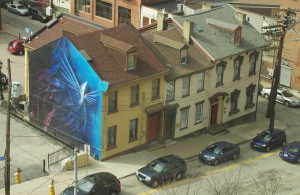
By: Seth Culp-Ressler | The Duquesne Duke
The Murphy and Wilms buildings aren’t exactly architectural staples of Duquesne’s campus. In fact, the little row of houses along Chatham Square are a little bit mysterious for many, despite being one of the more recent acquisitions of the University.
Of the three conjoined houses situated across the street from the Power Center only two actually belong to Duquesne. Eighteen Chatham Sq., the Wilms Building, contains the Center for Spiritan Studies and the Center for the Catholic Intellectual Tradition. To the left of it is the Murphy Building, noteworthy for the sizable mural on its Forbes-facing outer wall, which houses the Center for Teaching Excellence and the Office of Service-Learning. Sixteen Chatham Sq., on the right side of the Wilms Building, is the office of the Villanova Law Firm.
A little digging around provided some answers to these mysterious row houses, at least as to when Duquesne came into the picture. According to the Allegheny County Office of Property Assessments’ online records database, both buildings were purchased by the University in 2007. The Murphy Building was bought on Oct. 4, while the Wilms building was acquired almost a month earlier on Sept. 13. No notable information about the buildings’ existences prior to Duquesne’s acquisition of them is available.
Tom White, University archivist and curator of special collections, says that he actually has next to no information on the buildings in his records; he doesn’t even have a place for them in his building and property files.
“There’s just really not a lot there,” White said. “I get people asking me about this frequently, actually, and I’ve tried finding some other stuff, and short of doing a full on search of the old newspapers there really isn’t a lot.”
He said that from his time as a graduate student at Duquesne in the ‘90s that he did know for sure that before the school bought them the buildings were all law offices.
Lina Dostilio, director of Academic Community Engagement for the Office of Service-Learning, works in 20 Chatham. After Duquesne purchased the buildings, significant renovations were performed before any occupation took place. The Office of Service-Learning moved in during the fall 2008, as did the Honors College offices, prior to their relocation to Assumption Hall a few years later.
Dostilio said that they had an open house to celebrate the occasion, where President Dougherty, among others, came to see the building. At the open house, Dougherty complimented Dostilio’s decorations, but she recommended one more piece to the building: a mural.
The artist chosen was Gerard Tonti and the mural, one of the most recognizable aspects of the buildings, is titled “Elevate.” As the Fall 2010 edition of Duquesne University Magazine reported, it depicts “a rising dove, representing the Holy Spirit.” The mural was finished in June of 2010.
As The Duke reported a year later in October 2011, Tonti is also the artist responsible for “I am because we are,” the mural painted along Academic Walk on the side of the Laval House.
Dostilio said that while the offices may be slightly off the radar for most of the student body, they are actually hubs of significant activity for Duquesne.
“My office is pretty much the center that helps the university get involved with the community,” Dostilio said.“The other office [The Center for Teaching Excellence] located here pretty much helps to improve the quality of teaching. These are two really big, important parts of the University’s mission, so a lot of business goes on here. But most people don’t know about it.”
Dostilio said that in the beginning of her time in the building there were some feelings of “moving off campus” and of being disconnected from the school. But now she loves being in Chatham because of how it allows for that reach off campus.
“I like that we’re on the street-scape, because of what we do, because we’re so engaged with the community, people can find us.” she said. “You wouldn’t believe how many people ring the doorbell because they want information about Duquesne University, and this is like a front door.”
“They might not feel welcomed all the way up top, but here it’s a little bit more street-scape. So I appreciate the ethos of it. You know, it kind of gives us a better connection to the surrounding community.”


